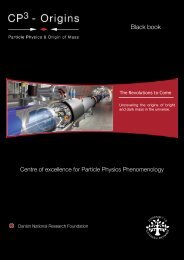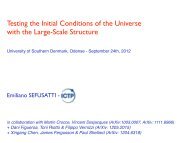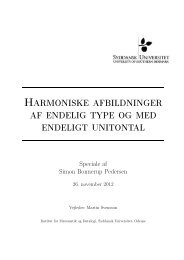2nd Black Book - CP3-Origins
2nd Black Book - CP3-Origins
2nd Black Book - CP3-Origins
Create successful ePaper yourself
Turn your PDF publications into a flip-book with our unique Google optimized e-Paper software.
Nonperturbative Results for Yang-Mills Theories<br />
Some non perturbative aspects of the pure SU(3) Yang-Mills theory are investigated assuming a<br />
specific form of the beta function, based on a recent modification by Ryttov and Sannino of the<br />
known one for supersymmetric gauge theories. The characteristic feature is a pole at a particular<br />
value of the coupling constant, g. First it is noted, using dimensional analysis, that physical<br />
quantities behave smoothly as one travels from one side of the pole to the other. Then it is argued<br />
that the form of the integrated beta function g(m), where m is the mass scale, determines<br />
the mass gap of the theory. Assuming<br />
the usual QCD value one finds it to be<br />
1.67 GeV, which is in surprisingly good<br />
agreement with a quenched lattice calculation.<br />
A similar calculation is made for<br />
the supersymmetric Yang-Mills theory<br />
where the corresponding beta function is<br />
considered to be exact.<br />
Nonperturbative Results for Yang-Mills<br />
Theories.<br />
Francesco Sannino, (Southern Denmark U.,<br />
<strong>CP3</strong>-<strong>Origins</strong>) , Joseph Schechter, (Syracuse<br />
U.) . <strong>CP3</strong>-ORIGINS-2010-36, Sep 2010. (Published<br />
Nov 1, 2010). 6pp.<br />
Published in Phys.Rev.D82:096008,2010.<br />
e-Print: arXiv:1009.0265 [hep-ph]<br />
Hot Conformal Gauge Theories<br />
We computed the nonzero temperature free energy up to the order g6 ln(1/g) in the coupling<br />
constant for vector like SU(N) gauge theories featuring matter transforming according to different<br />
representations of the underlying gauge group. The number of matter fields, i.e. flavors, is<br />
arranged in such a way that the theory develops a perturbative stable infrared fixed point at<br />
zero temperature.<br />
Due to large distance conformality, we trade the coupling constant with its fixed point value<br />
and define a reduced free energy which<br />
depends only on the number of flavors,<br />
colors and matter representation. We<br />
showed that the reduced free energy<br />
changes sign, at the second, fifth and<br />
sixth order in the coupling, when decreasing<br />
the number of flavors from the<br />
upper end of the conformal window. If<br />
the change in sign is interpreted as signal<br />
of an instability of the system then<br />
we infer a critical number of flavors.<br />
Surprisingly this number, if computed to<br />
the order g2, agrees with previous predictions<br />
for the lower boundary of the<br />
conformal window for nonsupersymmetric<br />
gauge theories. The higher order<br />
24 CP³-<strong>Black</strong> book








